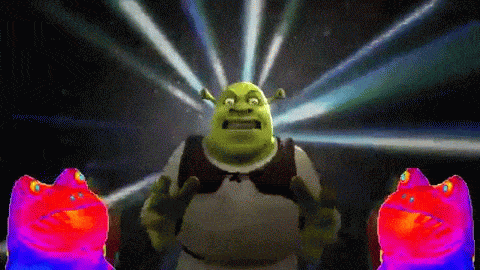- 13,816
- 15,045
Pixel movement is more arbitrary than a snail movement.Would it be possible if we can just lowball and say said objects were moving a pixel per second even if said object/background was frozen in place if we cannot use snail speed?
Follow along with the video below to see how to install our site as a web app on your home screen.
Note: This feature may not be available in some browsers.
Pixel movement is more arbitrary than a snail movement.Would it be possible if we can just lowball and say said objects were moving a pixel per second even if said object/background was frozen in place if we cannot use snail speed?
I can understand the argument but a picture with different pixel quality can already arbitrarily affect the result. Therefore, even more arbitrary.The argument is that the movement cannot be perceived by us the viewer then it moved by a pixel at most.
we're using planck time for this now?
damn, mftl+ shrek confirmed

this would unironically make shrek faster than barry allen
Could say so.so if somebody views time as frozen for 7 seconds, that means that they perceive 0.2 seconds as 7 seconds?
BumpIf a moving object is shown as frozen (as in, we have two panels that you can overlay over each other and there definitely is no difference in the object) then saying that the object moved less than the smallest distance we can measure for that panel appears reasonable.
However, it is true that one has to be careful with that. At the first glance, the smallest measurable distance in a picture is a pixel, but as Jasonsith said the picture quality can change that. In principle, one can take a small picture and upscale it by a million to make the moved distance a million times smaller that way.
Perhaps using something like the width of a line, which doesn't change with upscaling, would be more reasonable.
Well, currently we use 1px. However, if you simply upscale by 1000x then using 1 px makes the distance 1000x smaller and hence the feat 1000x more impressive.Bump
How would the width of a line be used here anyway?
Also I'm not sure how you could upscale a picture to a higher resolution properly without making it look like ass when one zooms in. Only way to not make it look like ass is to play the media in its native resolution, like say, movies have 1080p variants and 4K UHD variants. Same with Games, that have native resolutions to pick from but need the monitor support for it and YouTube isn't exactly the best place to expect the quality to be retained.
So, say the diameter of a bullet is 42px. Line width is 3px as you said.Well, currently we use 1px. However, if you simply upscale by 1000x then using 1 px makes the distance 1000x smaller and hence the feat 1000x more impressive.
So what one could do is take something like the width of a line as smallest identifiable feature in the drawing. Say that line is 3px wide. Now you can still upscale, but in doing so the line also becomes thicker. Upscaling 1000x bigger makes the line 3000px thick and hence the distance the object is assumed to have moved at most stays the same as before the upscaling.
The distance moved? Just... with scaling? Like usual. It doesn't really effect the distance part of the calc.So, say the diameter of a bullet is 42px. Line width is 3px as you said.
It is available as frozen for half a second before it disappears from the screen.
How do we figure out the distance moved within that timeframe then?
Okay, so lemme do this.The distance moved? Just... with scaling? Like usual. It doesn't really effect the distance part of the calc.
Let me give an example:
With line width being 3px, you would assume the bullet moved at most 3px while it was frozen in place. Let's say through some scaling you figure out that 3px equals 0.000001m.
Assume the bullet moves 370 m/s.
Then the maximum timeframe that could have passed in the frozen time is 0.000001m / 370 m/s = 0.0000000027027027s.
Now that you have that timeframe you can use it for something else. E.g. say a very fast character moves 1 meter during that scene. (which you figure out through perfectly regular scaling)
Then you can use the timeframe and the 1 meter to calculate its speed: 1m/0.0000000027027027s = 370000000 m/s
Maybe? I'm not sure. How did you get the apparent speed of the bullet?Okay, so lemme do this.
Bullet diameter is 42px or 0.009 m (9mm). Line width is 3px.
Distance moved: 0.009/(42/3)= 0.00064285714 m.
Apparent speed of bullet: 0.00128571428 m/s
Let's say the character swung their arm in a 180 degree arc from rear to forward) in about 1/4 of a second during that slow-mo timeframe (Average arm length of a 1.7526 m tall person according to this is 0.766 m). So 2.40646 m moved in 0.25 seconds, so 9.62584 m/s apparent speed
Slow-mo formula is: (True speed / Apparent speed) * Person apparent speed
True speed of person: (370/0.00128571428) * 9.62584= 2,770,102.85676 m/s or Mach 8076.10162321 (Massively Hypersonic+)
I get it right?
IMO the thinnest line is fine. It just shouldn't be a corner or something. The fundamental point is just to use something that gets bigger if you upscale the image, so that the image resolution isn't a factor in the result.Also what if people use thicker lines or thinner lines? That can also become problematic. What thickness line should we use?
Yikes, that was an oopsie on my part. Fixed now.Maybe? I'm not sure. How did you get the apparent speed of the bullet?
Well, paint.net gives me the thinnest usable brush width to be 1px. Is that fine? That wouldn't affect visibility problems for other users, would it?Maybe? I'm not sure. How did you get the apparent speed of the bullet?
IMO the thinnest line is fine. It just shouldn't be a corner or something. The fundamental point is just to use something that gets bigger if you upscale the image, so that the image resolution isn't a factor in the result.
That uses the additional assumption that the time is slowed down by a constant amount, but that's usually an acceptable assumption to make. So that should work, yeah.Yikes, that was an oopsie on my part. Fixed now.
Hmmmm, there might be a misunderstanding here? When I talk about the width of a line, I mean one the author of the anime/manga/comic/cartoon used.Well, paint.net gives me the thinnest usable brush width to be 1px. Is that fine? That wouldn't affect visibility problems for other users, would it?


Ah. I understand.That uses the additional assumption that the time is slowed down by a constant amount, but that's usually an acceptable assumption to make. So that should work, yeah.
Hmmmm, there might be a misunderstanding here? When I talk about the width of a line, I mean one the author of the anime/manga/comic/cartoon used.
Like, take this panel:

For the width of a line you would pick some line and scale its width. Like this:

(You might need to zoom in to see where I have drawn the red line)
So in this case you might use 3.6px as the value.
Huh, good question. In video games, one could maybe still manage, depending on the art style, but for life action movies it could be a problem...Ah. I understand.
But what about video games and movies where such a line may be next to impossible to determine simply because of how high-definition they can be? What's the answer for them?
That'd work only if the game had comic-book-esque artworks, like anime games. Not for games that have decent graphical fidelity or photorealistic graphics or similar (Basically most modern triple-A games or such). And the lines there can be... let's just say, wildly and unpredictably inconsistent not just because of the polygon count, but just because of the mere fact that games today have become considerably more advanced to the point where if you wanted to know finer details you'd have to start tinkering with the game files themselves.Huh, good question. In video games, one could maybe still manage, depending on the art style,
Aye, I knew it was gonna be a problem the moment someone tried to use it especially for live-action movies. And smallest detail can kind of vary, it's not like the slow motion scenes are always shown in vivid detail and can often be a blurry mess. Worse still, getting the OG 4K Blu-Ray shots can be a nightmare since you need the right monitor for it, otherwise without decent-enough HDR on your monitor (Good luck getting a 1000-nit monitor without forking over 2000 USD) the image can appear... well let's just say it's not gonna be in any watchable condition, period.but for life action movies it could be a problem...
One would presumably use something else as "smallest detail" than the line width. Just not sure what would be suitable for that.
Using hair is prolly not the safest idea, since for it to be visible it'd need to be low-resolution AF, higher resolutions and graphical fidelity, and hair lines become so thin that it might actually become undetectable by Paint.net and the like.In theory one could say that the smallest detail than can be seen even at a low resolution could be used, but... that would just lead to debates whether a hair or something is visible or not.
Normally I'd be fine with 1080p at the bare minimum but then the 4K resolutions exist which would prolly give us a much cleaner and crisper value.If that doesn't work... maybe we should define a certain resolution that needs to be used for such feats and then we use 1px as usual?
480p and 720p? Jeez, kinda low-quality for modern video games and movie clips, don'tcha think?I wouldn't go with 4k already because most videos won't be available in that quality at all.
I would go 480p or 720p or something. When in doubt it's prolly better to downscale videos than to upscale them.
Video formats aside, the topic is harder for images, as there is much less standardization.
I mean, one can always downscale.480p and 720p? Jeez, kinda low-quality for modern video games and movie clips, don'tcha think?
I mean, it makes sense for anime that are 30 years old as they were native resolution and given that it's basically animation, my concern is more or less modern-day 3-D games that easily have support for 1080p resolutions and the like, and for movies that now have official 4K remasters and whatnot.I mean, one can always downscale.
And consider that we also do calcs for stuff like 30 year old anime. And heck, even these days many youtube videos of stuff are only 720p.